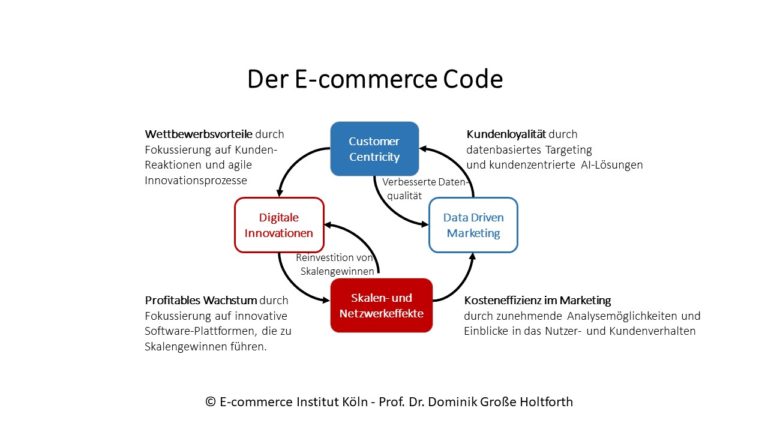
E-commerce strategy
The e-commerce strategy is crucial in order to be profitable with an online shop in the long term. It encompasses the business model, unique selling points and success factors that bring companies to the forefront of the competition. A successful e-commerce strategy is based on customers and competitors and implements the success factors of digitalization.
The e-commerce institute supports you in developing your success strategy and shows you ways to implement it and increase profitability in e-commerce. Use the short line to the E-Commerce Institute Cologne: 0221 973199722 or info@ecommerceinstitut.de.
The basic strategy: the e-commerce code
In the dynamics of e-commerce, a sustainable strategy depends on recognizing opportunities early on and taking them as early as possible. This creates competitive advantages and advantages that increase the profitability of the e-commerce company. The basis for any discovery of opportunities is the observation of structural changes in the markets as well as in relevant sectors and areas of the economy.
In e-commerce, the diffusion of technologies and the innovative and marketing power of companies is a decisive driver for further growth in e-business and e-commerce. But the growth phase is not linear, the dynamics of parallel processes can be very different.
The basic e-commerce strategy is based on the empirically recognizable trends in customer behaviour and competitors and aligns the four key factors in e-commerce with them. These strategic success factors, which are derived from the E-Commerce Code, determine the success of many leading e-commerce companies, thus providing a strategic benchmark for the entire industry. The interaction of the four factors is shown in the diagram below.
The trends – customer behaviour and competition
Against the background of the multitude and variety of trends, a focus and, first of all, a strict orientation towards customer behaviour is crucial for a successful e-commerce strategy. Only changing customer behaviour has made e-commerce a notable sales channel. As the reach of the company increases, there is a potentially expanded access to customers on the one hand and increased competition on the other. Due to the spread of the Internet and its central mechanisms, competition for all companies is more intense than in the stationary, non-networked economy.
The competition takes place on two levels: competition for access to the customer and competition for the customer’s purchase decision. A sufficient online marketing strategy and competition strategy is central in the access competition, while the competition for the purchase decision is about products, prices, services as well as usability and user experience (UX), which can become success factors of your e-commerce strategy.
The role of innovation
Last but not least, innovation is an essential determining factor for the selection of a suitable e-commerce strategy. Even if the behaviour of the customer should be at the beginning of the strategy process, technology and innovation are the main drivers of change in connection with e-commerce. Customers react to technological changes, accept them in the form of new devices and applications or ignore them. Therefore it is important with the e-commerce strategy to observe technological trends, ideally to anticipate them and, if there is a sufficient chance of acceptance of technology, to use them.
The customer in the center – customer centricity
Game changer in the digital period is the transparency of customer behaviour. At the same time, customers can choose from an ever-increasing number of offers, read reviews and submit reviews themselves. At the same time, competitive pressure increases online marketing costs. As a strategic response, more and more companies are switching to a customer-centric strategy with the aim of increasing customer loyalty. Long-term customer loyalty helps to realize marketing costs and to understand and solve customer needs. Ultimately, the core of the Amazon strategy is customer loyalty, so that Amazon, as a leading e-commerce company, sets the benchmark.
Growth and Platforms
Digital systems and platforms are at the center of e-commerce operations. But logistics also enables economies of scale due to falling average costs. In this respect, an e-commerce strategy must always contain a growth strategy. This is the only way that innovations, digital platforms and logistics systems can be financed and used efficiently. Online marketing is of central importance in the growth strategy.
Data-Driven Marketing
The immediate availability of usage data makes analysis, and especially web analysis, a decisive factor in a successful e-commerce company. Data-driven marketing means that marketing decisions in particular, but also product and system decisions, should be made based on data. Data-Driven Marketing Costs enables you to break down marketing costs precisely and thus significantly increase marketing efficiency.
This basic e-commerce strategy is essential for every company that is active in e-commerce due to its high relevance and prevalence among the leading e-commerce companies. A differentiation strategy is also important for developing unique selling points.
E-commerce differentiation strategy
When defining a strategy, a company can choose from classic strategy types that are adapted for its own company.
Price leadership
The basic strategy provides the basis for efficiency advantages of an e-commerce company over its competitors through economies of scale and the use of technology, but also through data-driven marketing. This is especially true for price leadership, as this requires cost leadership at all levels of the supply chain. The price leader strategy in e-commerce is characterized by an offensive drive for growth, high initial losses to achieve long-term dominance. Securing the financing of any initial losses is, therefore, an essential task of this e-commerce strategy. If it succeeds, the price leader can achieve high market shares due to its dominance.
Quality leadership
Quality leadership, on the other hand, means achieving high market shares through exclusive and particularly attractive products. As a result, ensuring access to these products is crucial. This strategy is ideal for manufacturers. The greater willingness of customers to pay for special quality is also positive. Consequently, a central point of the quality leader strategy is to bind customers to the company in the long term. An important KPI is, therefore, the customer lifetime value.
Marketplace or network strategy
The marketplace or network strategy puts the product range in the focus of a growing platform or marketplace. A large assortment is one of the most important motives for customers to shop online. If the customers are still satisfied, they remain loyal to a marketplace. This, in turn, is attractive for retailers who offer their goods on the marketplace so that new customer segments can be opened up.
Growth of the platform on the customer and dealer side drops the average costs so that the prices can also be reduced. Further customers are reached. As you can easily see, Amazon, in particular, is pursuing this e-commerce strategy.
Niche or blue ocean strategy
A sub-form of the quality leadership strategy is a niche or blue ocean strategy. In both cases, a company focuses on product differentiation that leads to a smaller market segment. Marketing via the Internet makes the niche product a sufficient market thanks to the better accessibility of dispersed target groups.
With a blue ocean strategy, the niche product is first created by differentiating an existing product. Product properties and marketing priorities are being redesigned contrary to industry practices so that a new market segment is created. However, the new product and its deviating, atypical properties must first be communicated to potential customers, which makes the blue ocean strategy complex and risky.
Internationalization strategy
The growth-oriented pricing strategy, in particular, will soon allow market development in the home market to reach a saturation point. Further growth is then only possible in foreign markets so that an internationalization strategy makes sense for market leaders in e-commerce.
Since internationalization is very complex, this strategy must be very well prepared and implemented professionally. Especially in the European single market, which brings together many customers in different cultures and with different languages, the internationalization strategy is fundamentally interesting, but also complex.
Support in the implementation of e-commerce strategy
One of the tasks of the E-Commerce Institute is to recognize trends in e-commerce on a technological and international level and to incorporate them into concepts. We support you in creating and implementing new concepts. Do you have any questions regarding the selection and implementation of your e-commerce strategy? Then we look forward to hearing from you at info@ecommerceinstitut.de.
Author: Prof. Dr. Dominik Große Holtforth
